Tire and Wheel Runout Measurement Cast-type Wheels
Tools Required
| • | J 34481 Universal
Flexible Magnetic Dial Indicator Stand |
- Inspect the following components:
| • | The torque of the wheel nuts |
| • | The torque of the wheel clamp nuts |
| • | The rim and spoke mating surfaces. Verify that the surfaces are
clean and free of distortions and corrosion. |
| • | All spokes for even rim alignment |
| • | The spoke-to-drum and the spoke-to-hub mating surfaces. Verify
that the surfaces are clean and free of distortions and corrosion. |
- Raise and support the axle on the side which you are preparing
to inspect.
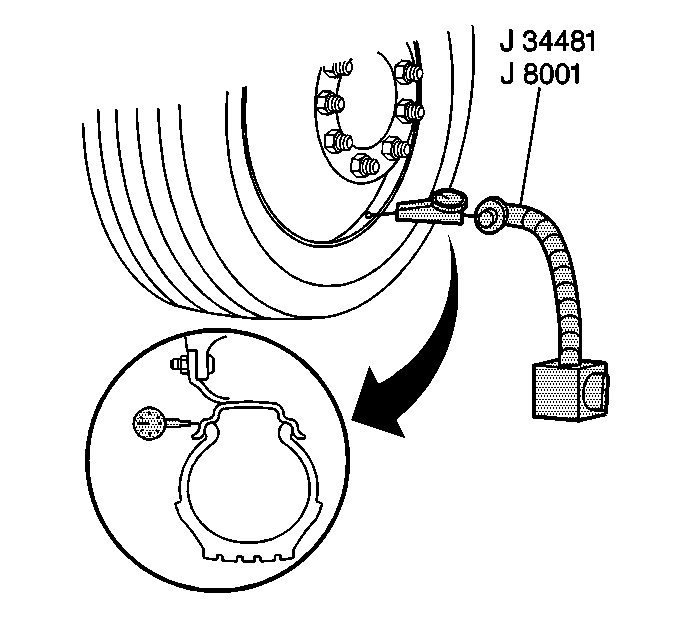
Important: Do NOT position J 8001
at
the end of the rim flange. When checking runout, exclude the area within two
degrees of the rim butt weld.
- Position J 34481
so
that J 8001
contacts the
rim surface.
- Measure the wheel lateral runout using J 8001
while gently turning the wheel.
Reading
The lateral runout at the rim should not exceed 1.8 mm (0.07 in).
If the wheel is distorted more than 1.8 mm (0.07 in), replace
the rim.
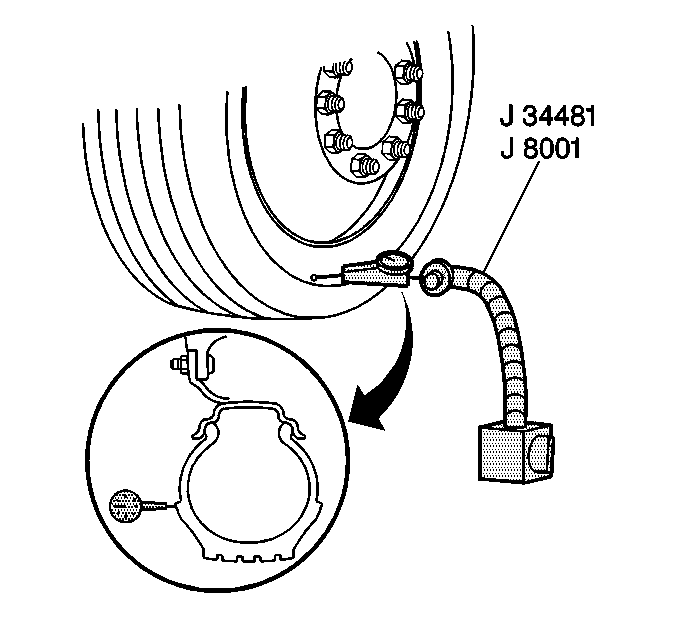
- Position J 34481
so that J 8001
contacts the tire surface.
- Measure the total lateral runout using J 8001
while gently turning the wheel.
Reading
The total lateral runout at the tread edge should not exceed 3.1 mm
(0.125 in).
| 6.1. | If the wheel is distorted more than 3.1 mm (0.125 in),
replace the rim. |
| 6.2. | Loosen the wheel clamp nuts and re-torque. Refer to
Wheel Installation
in Tires and Wheels. |
| 6.3. | Recheck the runout. If the runout exceeds this measurement, replace
the rim. |
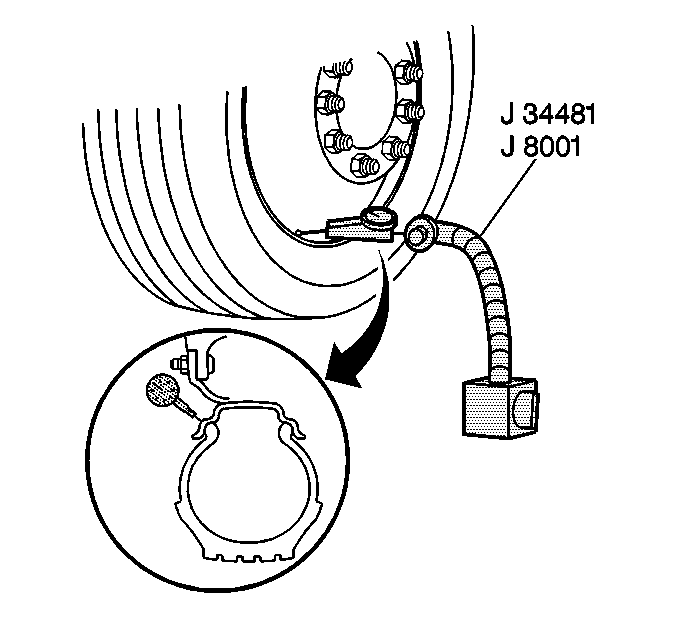
- Position J 34481
so that J 8001
contacts the rim surface.
- Measure the radial runout using J 8001
while gently turning the wheel. Observe the high spots on the
rim surface.
Reading
The radial runout at the rim should not exceed 3.1 mm (0.125 in).
If the wheel is distorted more than 3.1 mm (0.125 in), replace
the rim.

- Position J 34481
so that J 8001
contacts the tire surface.
- Measure the total radial runout using J 8001
while gently turning the wheel.
| • | For single wheels, loosen the wheel clamp nuts and re-torque.
Refer to
Wheel Installation
in Tires
and Wheels. Recheck the runout. If the runout exceeds this measurement, replace
the rim. |
| • | For dual wheels, loosen the wheel clamp nuts of the outer wheel.
Rotate the wheel in order to match with the high point of the inner wheel.
Re-torque the wheel clamp nuts. Refer to
Wheel Installation
in Tires and Wheels. Recheck the runout. If the
runout exceeds this measurement, replace the rim. |
Tire and Wheel Runout Measurement Disc-type Wheels
Aluminum Disc-type Wheels
Tools Required
| • | J 34481 Universal
Flexible Magnetic Dial Indicator Stand |
- Inspect the torque of the wheel nuts.
- Inspect the rim-to-drum or the rim-to-hub mating surfaces. Verify
that the surfaces are clean and free of distortions and corrosion.
- Remove the tire-wheel assembly. Refer to
Wheel Removal
in Tires and Wheels.
- Remove the tire from the wheel. Refer to
Tire Mounting and Dismounting
in Tires and Wheels.
- Clean the rim-to-hub or the rim-to-drum mating surface and install
the rim. Refer to
Wheel Installation
in Tires and Wheels.
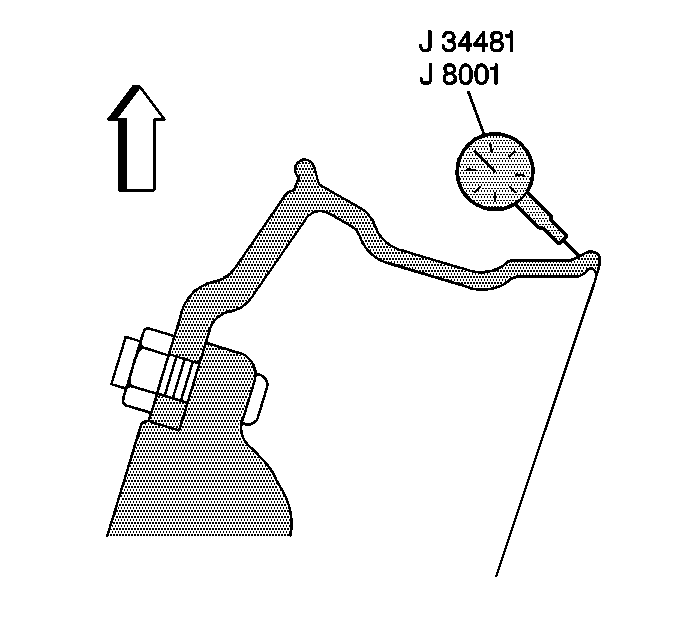
- Position J 34481
so that J 8001
contacts the rim surface.
- Measure the wheel lateral runout using J 8001
while gently turning the rim.
Reading
The lateral runout at the rim should not exceed 3.1 mm (0.125 in).
If the rim exceeds this measurement, replace the rim.
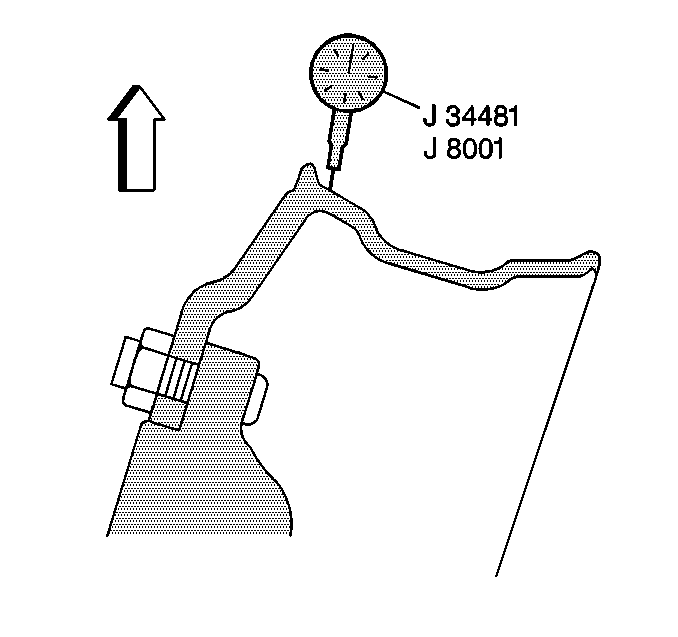
- Position J 34481
so that J 8001
contacts the rim surface.
- Measure the wheel radial runout using J 8001
while gently turning the rim.
Reading
The radial runout at the rim should not exceed 3.1 mm (0.125 in).
If the rim exceeds this measurement, replace the rim.

- Mount the tire to the
wheel. Refer to
Tire Mounting and Dismounting
in Tires and Wheels.
- Install the tire-wheel assembly. Refer to
Wheel Installation
in Tires and Wheels.
- Position J 34481
so that J 8001
contacts
the tire surface.
- Measure the total radial runout using J 8001
while gently turning the wheel.
Reading
The radial runout at the rim should not exceed 3.1 mm (0.125 in).
- If the wheel exceeds this measurement, demount the wheel. Clean
the rim-to-tire mating surfaces and mount the wheel to the rim. Refer to
Tire Mounting and Dismounting
in Tires and Wheels.
- Return to the previous step and recheck the runout.
Off-Vehicle Hub and Wheel Check
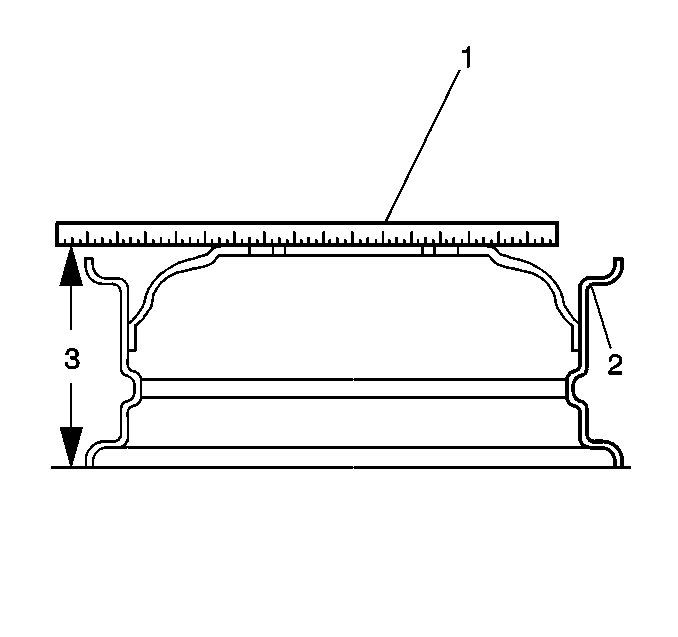
- Place a straightedge on
the face or the hub of the wheel.
- Measure the distance from the straightedge (1) to the edge of
the rim (2) at four equally spaced locations. If the distance (3) is the same
at all positions, then the wheel is not distorted.
You may also check a dismounted wheel for radial and lateral runout.
Temporarily mount the wheel to a hub on the vehicle. Follow the procedure
for the On-Vehicle Check.
On-Vehicle Hub Check
If you are not certain whether the wheel or the hub is distorted, check
the hub using the following procedure:
- Replace the existing wheel with a wheel known to be good.
- Turn the wheel and perform the same measurements shown in the
previous procedure.
If the measurements are within the limits of 2.3 mm (0.0938 in)
laterally and radially, then the wheel is good, but the hub is sprung.
Steel Disc-type Wheels
Tools Required
| • | J 34481 Universal
Flexible Magnetic Dial Indicator Stand |
- Inspect the torque of the wheel nuts.
- Inspect the rim-to-drum or the rim-to-hub mating surfaces. Verify
that the surfaces are clean and free of distortions and corrosion.
- Raise and support the axle on the side that you are preparing
to inspect.

- Position J 34481
so that J 8001
contacts the rim surface.
- Measure the wheel lateral runout using J 8001
while gently turning the rim.
Reading
| • | The lateral runout at the rim should not exceed 3.1 mm
(0.125 in) for single wheels. |
| • | The lateral runout at the rim should not exceed 4.7 mm
(0.187 in) for dual wheels. |
- If the rim exceeds this measurement, replace the rim.

- Position J 34481
so that J 8001
contacts the tire surface.
- Measure the total lateral runout using J 8001
while gently turning the wheel.
Reading
| • | The lateral runout at the rim should not exceed 3.1 mm
(0.125 in) for single wheels. |
| • | The lateral runout at the rim should not exceed 4.7 mm
(0.187 in) for dual wheels. |
- If the wheel exceeds this measurement, demount the wheel. Clean
the rim-to-tire mating surfaces and mount the wheel to the rim. Refer to
Tire Mounting and Dismounting
in Tires and Wheels.
- Return to the previous step and recheck the runout.

- Position J 34481
so that J 8001
contacts the rim surface.
- Measure the wheel radial runout using J 8001
while gently turning the wheel.
Reading
The radial runout at the rim should not exceed 3.1 mm (0.125 in).
If the rim exceeds this measurement, replace the rim.

- Position J 34481
so that J 8001
contacts the tire surface.
- Measure the total radial runout using J 8001
while gently turning the wheel.
Reading
The radial runout at the rim should not exceed 3.1 mm (0.125 in).
- If the wheel exceeds this measurement, demount the wheel. Clean
the rim-to-tire mating surfaces and mount the wheel to the rim. Refer to
Tire Mounting and Dismounting
in Tires and Wheels.
- Return to the previous step and recheck the runout. if runout
is excessive, replace the rim.
Off-Vehicle Hub and Wheel Check

- Place a straightedge on
the face or the hub of the wheel.
- Measure the distance from the straightedge (1) to the edge of
the rim (2) at four equally spaced locations. If the distance (3) is the same
at all positions, then the wheel is not distorted. You may also check a
dismounted wheel for radial and lateral runout. Temporarily mount the wheel
to a hub on the vehicle. Follow the procedure for the On-Vehicle Check
On-Vehicle Hub Check
If you are not certain whether the wheel or the hub is distorted, check
the hub using the following procedure:
- Replace the existing wheel with a wheel known to be good.
- Turn the wheel and perform the same measurements shown in the
previous procedure.
If the measurements are within the limits of 2.3 mm (0.0938 in)
laterally and radially, then the wheel is good, but the hub is sprung.













